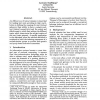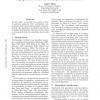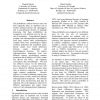117
Voted
ACL
1998
15 years 2 months ago
1998
Several methods are known for parsing languages generated by Tree Adjoining Grammars (TAGs) in O(n 6) worst case running time. In this paper we investigate which restrictions on T...
141
Voted
ACL
1998
15 years 2 months ago
1998
This paper proposes a learning method of translation rules from parallel corpora. This method applies the maximum entropy principle to a probabilistic model of translation rules. ...
100
Voted
ACL
1998
15 years 2 months ago
1998
Much of the power of probabilistic methods in modelling language comes from their ability to compare several derivations for the same string in the language. An important starting...
98
Voted
ACL
1998
15 years 2 months ago
1998
We propose a comprehensive theory of codemixed discourse, encompassing equivalencepoint and insertional code-switching, palindromic constructions and lexical borrowing. The starti...
86
Voted
ACL
1998
15 years 2 months ago
1998
An efficient use of lexical cohesion is described for ranking text units according to their contribution in defining the meaning of a text (textual saliency), their ability to for...
86
Voted
ACL
1998
15 years 2 months ago
1998
In this paper, we provide an account of how to generate sentences with coordination constructions from clause-sized semantic representations. An algorithm is developed and various...
110
Voted
ACL
1998
15 years 2 months ago
1998
For the task of recognizing dialogue acts, we are applying the Transformation-Based Learning (TBL) machine learning algorithm. To circumvent a sparse data problem, we extract valu...
103
Voted
ACL
1998
15 years 2 months ago
1998
We present an architecture and an on-line learning algorithm and apply it to the problem of part-ofspeech tagging. The architecture presented, SNOW, is a network of linear separat...
73
Voted
ACL
1998
15 years 2 months ago
1998
We discuss an interactive approach to robust interpretation in a large scale speech-to-speech translation system. Where other interactive approaches to robust interpretation have ...
97
Voted
ACL
1998
15 years 2 months ago
1998
The probabilistic relation between verbs and their arguments plays an important role in modern statistical parsers and supertaggers, and in psychological theories of language proc...



